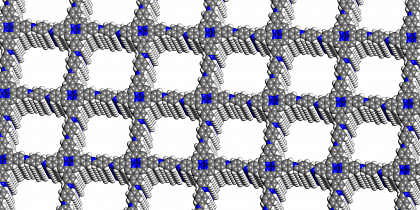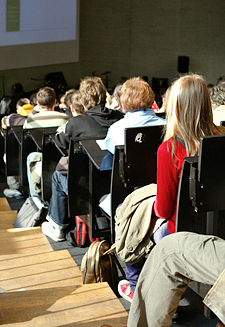Research
Our research goal is to develop fundamentally new ways to synthesize covalent materials. With control and understanding of the synthetic pathways, we seek to create highly crystalline and functional materials.
In our group, we are working on a class of materials where exceptional control over material structure and composition is possible due to a reticular structure. These reticulated materials are constructed from organic building blocks combined with either metal-organic nodes to form metal-organic frameworks (MOFs) or reversible covalent bonds to form covalent organic frameworks (COFs). By using rigid building blocks with strong directional bonds between them, crystalline, porous and highly functional materials can be obtained.

Structure of a porphyrin-based covalent organic network.
The structures of these net-like materials can be directly traced back to the geometry, shape and properties of the organic building blocks. We therefore use creative chemistry to design new building blocks and thus structures. In addition to organic synthesis of building blocks and the resulting materials, we intensively study the often complex structure of these materials using X-ray diffraction (SC-XRD, PXRD, PDF, etc) as well as spectroscopic methods (IR, ssNMR, UV-Vis).
Current Projects
Frustrated Assembly
Synthesis of intentionally frustrated linker systems leads to emergent behavior and complexity and can itself be used as a design tool. Frustration is achieved by designing building blocks whose local geometry or symmetry is incompatible with the formation of extended structures.
Examplary Publication:
F. Haase*, G. Craig, M. Bonneau, K. Sugimoto, S. Furukawa*
“Pseudo-5-Fold-Symmetrical Ligand Drives Geometric Frustration in Porous Metal-Organic and Hydrogen-Bonded Frameworks ”
J. Am. Chem. Soc. 2020, 142, 32, 13839–13845
Topochemical Reactions
Reticular materials are usually porous and their internal structure is therefore accessible to perform reactions on the pore walls and linker backbones. Chemical manipulation of the backbone of reticular materials can greatly affect the structure and properties of the material.
Examplary publication:
F. Haase, E. Troschke, G. Savasci, T. Banerjee, V. Duppel, S. Dörfler, M. Grundei, A. M. Burow, C. Ochsenfeld, S. Kaskel, B. V. Lotsch,
“Topochemical conversion of an imine- into a thiazole-linked covalent organic framework enabling real-structure analysis ”
Nat. Comm. 2018, 9:2600.
New pathways to covalent materials
In currently available synthetic routes for crystalline covalent materials, many interesting properties, such as conductivity, are lost. Therefore, we are investigating new synthetic routes that can build crystalline materials also with strong covalent bonds, where these properties are retained.





